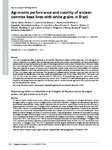Por favor, use este identificador para citar o enlazar este ítem:
http://www.alice.cnptia.embrapa.br/alice/handle/doc/997473Registro completo de metadatos
| Campo DC | Valor | Lengua/Idioma |
|---|---|---|
| dc.contributor.author | PEREIRA, H. S. | pt_BR |
| dc.contributor.author | BUENO, L. G. | pt_BR |
| dc.contributor.author | DEL PELOSO, M. J. | pt_BR |
| dc.contributor.author | ABREU, A. de F. B. | pt_BR |
| dc.contributor.author | MOREIRA, J. A. A. | pt_BR |
| dc.contributor.author | MARTINS, M. | pt_BR |
| dc.contributor.author | WENDLAND, A. | pt_BR |
| dc.contributor.author | FARIA, L. C. de | pt_BR |
| dc.contributor.author | SOUZA, T. L. P. O. de | pt_BR |
| dc.contributor.author | MELO, L. C. | pt_BR |
| dc.date.accessioned | 2014-10-16T11:11:11Z | pt_BR |
| dc.date.available | 2014-10-16T11:11:11Z | pt_BR |
| dc.date.created | 2014-10-16 | pt_BR |
| dc.date.issued | 2014 | pt_BR |
| dc.identifier.citation | Bragantia, Campinas, v. 73, n. 2, p. 130-137, 2014. | pt_BR |
| dc.identifier.issn | 1678-4499 | eng |
| dc.identifier.uri | http://www.alice.cnptia.embrapa.br/alice/handle/doc/997473 | pt_BR |
| dc.description | This work evaluated the effect of genotype by environment interaction in Andean common bean lines with white grains, in Central Southern Brazil, to identify lines with high agronomic performance, stability and adaptability, aiming to meet domestic demand and to increase the Brazilian participation in the foreign market of common bean. Nineteen trials with twelve Andean lines were conducted in 2007, 2008 and 2009, in Central Southern Brazil. Grain yield and other agronomic traits were evaluated. Data were subjected to analysis of variance and of adaptability/stability using Annicchiarico and modified AMMI methods. Significant differences were found between lines for all traits evaluated. Genotype by environment interaction was important for lines with Andean origin and white seed. The utilization of weighted mean of absolute scores and yield with the AMMI results enabled the identification of the most stable and adapted lines. Lines Poroto Alubia, CNFB 16211, Ouro Branco and WAF 160 were stable and adapted, using both methods. CNFB 16211 line presented high agronomic performance, stability and adaptability and therefore this line may be a new cultivar. USWA 70 and WAF 75 lines presented grain size similar to that required by the foreign market and superior to the Brazilian cultivars, besides favorable agronomic traits, and thus these lines may be indicated as new cultivars. | pt_BR |
| dc.language.iso | eng | eng |
| dc.rights | openAccess | eng |
| dc.subject | Grão especial | pt_BR |
| dc.subject | Grão branco | pt_BR |
| dc.title | Agronomic performance and stability of andean common bean lines with white grains in Brazil. | pt_BR |
| dc.type | Artigo de periódico | pt_BR |
| dc.date.updated | 2020-04-23T11:11:11Z | pt_BR |
| dc.subject.thesagro | Feijão | pt_BR |
| dc.subject.thesagro | Phaseolus vulgaris | pt_BR |
| dc.subject.thesagro | Melhoramento genético vegetal | pt_BR |
| dc.subject.thesagro | Interação genética | pt_BR |
| dc.subject.nalthesaurus | Ammi | pt_BR |
| riaa.ainfo.id | 997473 | pt_BR |
| riaa.ainfo.lastupdate | 2020-04-23 -03:00:00 | pt_BR |
| dc.identifier.doi | https://doi.org/10.1590/brag.2014.020 | pt_BR |
| dc.contributor.institution | HELTON SANTOS PEREIRA, CNPAF; LUICE GOMES BUENO; MARIA JOSE DEL PELOSO, CNPAF; ANGELA DE FATIMA BARBOSA ABREU, CNPAF; JOSE ALOISIO ALVES MOREIRA, CNPMS; MAURICIO MARTINS, UFU; ADRIANE WENDLAND FERREIRA, CNPAF; LUIS CLAUDIO DE FARIA, CNPAF; THIAGO LIVIO PESSOA OLIV DE SOUZA, CNPAF; LEONARDO CUNHA MELO, CNPAF. | pt_BR |
| Aparece en las colecciones: | Artigo em periódico indexado (CNPAF)  | |
Ficheros en este ítem:
| Fichero | Descripción | Tamaño | Formato | |
|---|---|---|---|---|
| bragantia.pdf | 377,36 kB | Adobe PDF |  Visualizar/Abrir |









